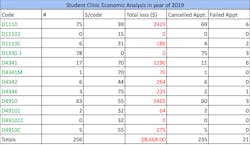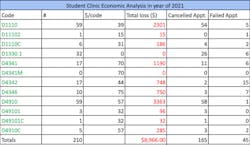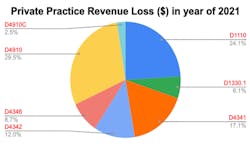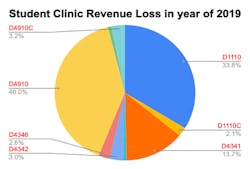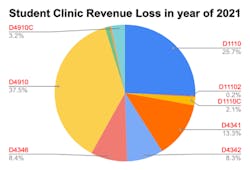The economic impact of no-shows on dental practices
Frustrated with gaps in your schedule due to patient no-shows and cancellations? Dissatisfied with your daily or yearly production? Did dental school prepare you for these obstacles in your private practice?
Shortly after starting our education at the University of Oklahoma College of Dentistry (OUCOD), we noticed that the student clinics were experiencing a high number of cancelled and failed appointments. We questioned the economic impact of these cancellations in our student clinics, but there was no clear answer.
The motivation behind our study was to provide valuable knowledge and awareness to students and to benefit OUCOD. Since this was a foundational study, we primarily looked at procedural codes associated with adult preventive prophylaxis and adult nonsurgical therapeutic periodontal treatments. Here is a summary of our journey to promote practice management education in academic settings, and the significant negative impact that no-shows contribute to practices and their patients.
You might also want to read: 6 steps to minimize failed appointments
What happens due to cancellations?
Quite a few consequences occur when patients fail to show for their dental appointments. We observed financial loss for the dental office, missed opportunities to provide care, and increases in future dental emergencies for patients who fail to show.1 There are opportunities for practices to grow 30%–50% in production during their first three years; however, no-shows slow this growth.
Dentists should set a daily production goal for success in their practices.2 When patients fail to show, dental practices have to compensate with same-day appointments or other avenues to reach their daily production goals.2 If a dental practice were to sustain one no-show per day for a year, they will lose $20,000 to $70,000.3 It’s possible to implement a system of communication with patients, whether phone, email, mail, or text confirmations,3 regarding their appointments to combat potential revenue loss from no-shows. Reducing no-show rates diminishes cost and improves the quality of health-care delivery.4
The expression production lost today is production lost forever gave us the inspiration to conduct this study. Private practices primarily use practice management software, practice management advisors, and dental financial consultants or dental CPAs to determine their financial losses due to no-shows. We calculated the total revenue loss in a theoretical private practice setting (figures 3 and 4 and tables 3–6) to show the impact of no-shows between the student clinic and a theoretical private practice.
The aim of our study was to explore the financial loss of no-shows in the student clinic program at OUCOD. We analyzed patient records from the academic years of 2019 and 2021 to determine the number of no-shows associated with procedural codes D1110, D4910, D4346, D4342, and D4341.
Additional subtype procedural codes shown in tables 1 to 4—D11102, D1110C, D1330.1, D4341M, D49101, D49101C, and D4910C—are directly associated with the main procedural codes. We did not include data from the year 2020 due to the impact of COVID-19 on clinic closures. By cross referencing a student program and private practice fee schedule with the total number of no-shows associated with each code, we determined the total financial revenue loss for 2019 and 2021.How much was lost?
Comparing figures 1 and 2, we observed a large financial loss in the student clinic associated with procedural codes D1110, D4910, and D4341. The total percentages of financial loss associated with these procedural codes are 87.5% in 2019 and 76.5% in 2021. As shown in tables 1 and 2, procedural codes D4346 and D4342 indicate a tripled cancelled or failed appointment rate, which directly contributed to a significantly higher increase in financial revenue loss from 2019 to 2021.
An initiative to increase diagnosing and treatment planning procedural codes D4346 and D4342 was started in 2021, hence increasing the likelihood of cancelled and failed appointments. We determined the student clinic at OUCOD suffered a total loss of $17,630 combined in 2019 and 2021, which is shown in table 5. In theoretical calculations based on our economic analysis within the student clinic, we determined a private practice would lose $61,490 combined in 2019 and 2021, shown in table 6.
A driving factor for our study was that no previous studies have been conducted at OUCOD that examine revenue loss from no-shows. While we investigated only the economic aspect of cancelled and failed appointments, remember that each lost appointment is a lost opportunity to provide dental care, which can affect oral health and overall health in our communities.
We have bridged the relevance of no-show appointments between a student clinic program and private practice setting. By limiting our foundational focus to 2019 and 2021, we will continue an economic analysis of future data. We also explored the implementation of electronic patient communication technology, enhanced phone communication scripting, and software management reporting tools in the student clinic as relevant opportunities to reduce no-shows. Data from our research will be used for further projects related to dental economics and practice management in an academic program.
Editor's note: This article appeared in the July 2023 print edition of Dental Economics magazine. Dentists in North America are eligible for a complimentary print subscription. Sign up here.
References
- Bhatia RC, Vora E, Panda A. (2018). Pediatric dental appointments no-show: rates and reasons.Int J Clin Pediatr Dent. 2018;11(3):171-176. doi.10.5005/jp-journals-10005-1506
- Levin RP. Practice production prioritized: Reducing no-shows. Dental Economics. October 7, 2021. Accessed May 27, 2022. https://www.dentaleconomics.com/practice/article/14209915/practice-production-prioritized-reducing-noshows
- McGuire J. No more no-shows. Dental Economics. January 17, 2014. Accessed May 27, 2022. https://www.dentaleconomics.com/practice/article/16390417/no-more-noshows
- Kheirkhah P, Feng Q, Travis LM, Tavakoli-Tabasi S, Sharafkhaneh A. Prevalence, predictors and economic consequences of no-shows. BMC Health Services Research. January 14, 2016. https://bmchealthservres.biomedcentral.com/articles/10.1186/s12913-015-1243-z#citeas
About the Author

Ghazaleh Elliott, BS
Ghazaleh Elliott, BS, is a current class of 2025 DDS candidate at The University of Oklahoma College of Dentistry. She represents her class in the Oklahoma Association of Women in Dentistry as well as mentors predental students on the road to dental school. Contact her at [email protected].

Manas Kommareddi, MA, BS
Manas Kommareddi, MA, BS, is a current Class of 2025 DDS candidate at The University of Oklahoma College of Dentistry. He serves in a variety of leadership and ambassador positions, in addition to being active in several dental organizations. Readh him at [email protected].

